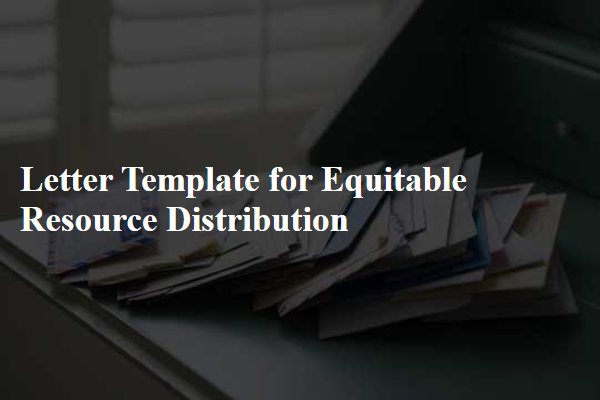Are you looking for a way to advocate for equitable resource distribution in your community? Writing a letter can be an effective way to express your thoughts and encourage others to take action. In this article, we'll explore how to craft a compelling letter that not only highlights the importance of fairness in resource allocation but also inspires change. Join us as we dive into the essential elements of crafting your message and discover tips for making your voice heard!

Clearly define objectives and purpose.
Equitable resource distribution aims to ensure fair allocation of assets, opportunities, and services among diverse communities within a specified region such as local governments or educational institutions. Addressing disparities in access to resources fosters social justice, enhances community well-being, and promotes economic development. By identifying key stakeholders including local residents, nonprofit organizations, and government agencies, this initiative seeks to establish transparent guidelines and metrics that assess needs based on demographic factors such as income levels, age distribution, and geographic location. Objectives include increasing resource accessibility, reducing inequality gaps, and empowering marginalized groups through tailored programs that reflect their unique needs and aspirations.
Highlight criteria for equitable distribution.
Equitable resource distribution hinges on criteria such as need, accessibility, and fairness. Need refers to assessing the specific requirements of different communities or populations, ensuring that those with the greatest challenges receive priority assistance. Accessibility involves evaluating logistical factors, including geographical location, infrastructure, and availability of services, ensuring resources reach the most vulnerable. Fairness assesses allocation based on socio-economic factors, historical injustices, and community engagement, ensuring all voices are heard in the decision-making process. Additionally, sustainability examines the long-term impact of resource use, promoting practices that protect the environment and foster economic stability for future generations.
Emphasize collaboration and stakeholder involvement.
Equitable resource distribution in community projects relies heavily on collaboration among diverse stakeholders, including local government, businesses, and residents. Engaging all parties ensures that resources are allocated based on need rather than power dynamics, fostering an inclusive approach. For instance, community forums such as those held in the city of Portland, Oregon, allow residents to voice their concerns and priorities. This dialogue facilitates transparency and accountability, enhancing trust within the community. Furthermore, incorporating data-driven assessments, such as demographic studies from the U.S. Census Bureau, can identify underrepresented groups facing resource shortages. By prioritizing these collaborative efforts, stakeholders cultivate an environment of shared responsibility, encouraging ownership and long-term sustainability of resources across the community.
Specify timeline and process details.
Equitable resource distribution requires a well-structured timeline and clear process details for successful implementation. The initial phase involves needs assessment (conducted over four weeks), identifying resource requirements across various sectors such as education, healthcare, and infrastructure. Following this, a data analysis period (lasting three weeks) synthesizes collected information to prioritize resource allocation. A stakeholder consultation phase (spanning two weeks) will integrate community feedback, ensuring transparency and inclusivity. Subsequently, the allocation phase (planned for two weeks) will utilize established criteria to distribute resources among identified sectors. Finally, an evaluation period (lasts four weeks) will assess the effectiveness of the distribution strategy, providing insights for future improvements. All phases will be documented to ensure accountability and transparency throughout the process.
Provide contact information for further inquiries.
Equitable resource distribution aims to ensure fair allocation of resources among communities, addressing disparities in access to essential services such as healthcare, education, and infrastructure. This initiative focuses on marginalized groups in urban and rural areas, aiming to eliminate barriers that lead to inequalities. An example includes local government programs that redistribute funding based on population needs and socioeconomic factors. Organizations like the United Nations and non-profits such as Oxfam actively engage in advocacy and research to promote equitable resource allocation. For further inquiries, contact information for resource distribution efforts can typically be found on official websites or community bulletins.













Comments